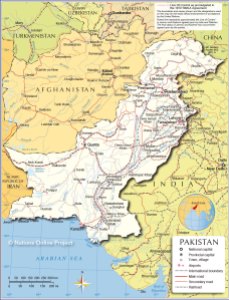For general information about the country profiles click here.
 Population: 179,160,111
Population: 179,160,111
HDI ranking: 146/187
HDI score: 0.515
Pakistan first pursued reforms for deeper decentralization in 1973 and again during 2000 and 2001. However, Iocal governments were suspended in 2010 and municipalities were placed under provincial authority (UCLG, 2010). In 2013, the Minister for Local Government announced the introduction of a new local government law under which local government elections would be conducted, but these elections have been postponed to an uncertain date (The Express Tribune, 2014).
Local governance at a glance
- Pakistan’s subnational government is composed of four provincial governments. Provinces are responsible for creating local governments with departments to administer local government matters. (UCLG, 2010).
- Local governments are divided into 112 Districts (rural areas) and City Districts (large metropolitan areas), 399 Tehsils or Towns, and 6,125 Union Councils (UCLG, 2010).
- Pakistan has legislated gender quotas in the form of reserved seats. At each local government levels and each administrative body, 33% of seats are reserved for women. In Provincial Assemblies, 22% of seats are reserved for women (Quota Project, 2014).
Civil society actors
- The Citizens’ Commission for Human Development (CCHD) runs education programs about local government and conducts advocacy campaigns on democratic governance (CCHD, 2012).
- National Integrated Development Association (NIDA) supports capacity building for good governance, citizen participation, and public/private sector development (NIDA, 2012).
Capacity building institutions
- Local Councils Association of the Punjab (LCAP) coordinates local governments in the Punjab province to promote participatory governance and facilitate joint action solutions to common issues (LCAP, 2013).
Fiscal control
- The central government holds the majority of fiscal power, though provincial governments may collect minor taxes. A substantial portion of provincial revenue is transferred to local governments, who depend solely on financing from intergovernmental transfers (UCLG, 2010).
- Local government authority over property remains suspended (UCLG, 2010).
Key initiatives for participatory local governance
- The Devolution of Power Plan passed in 2001 included electoral reform to local government structures and processes. This gave district governments authority over access to revenue and town governments over the functions of former municipal authorities (CJLG,2013).
- In 2001, Pakistan introduced a major territorial readjustment that increased Town Municipal Authorities’ area of responsibility and extended the levy of property taxes (UCLG, 2010).
- It was announced that the Punjab provincial government would reinstate its local government system and prepare for local elections by the end of 2013 (Daily Times, 2013).
Challenges for local participatory governance
- Institutionalizing political accountability at the local level has not been achieved. Local citizen control over civil servants remains weak (UCLG, 2010).
- The local government commission and the provincial finance commission do not have adequate capacity to protect local government rights (World Bank, 2010).
- Local governments face serious resource constraints. There is very limited access to local tax revenue and insufficient funds transfers from the provincial governments (UCLG, 2010).
- A new law and local government elections were scheduled for the end of 2013, but such was delayed indefinitely due to amendments (The Express Tribune, 2014).
List of sources:
Citizens’ Commission of Human Development (CCHD), 2012: http://cchd.org.pk/CCHD_Files/Democratic_Governance.html.
Commonwealth Journal of Local Governance (CJLG), 2013:”Pakistan’s Devolution of Power Plan 2001: A brief dawn for local democracy?”
Daily Times, 2013: “Features of Punjab Local Government Bill.”
Local Councils Association of the Punjab (LCAP), 2013: http://lcap.org.pk/.
National Integrated Development Association (NIDA), 2012: http://www.nidapakistan.org/ta8.php.
Quota Project, 2014: “Pakistan.”
The Express Tribune, 2014: ”ECP postpones local government elections in Punjab.”
United Cities and Local Governments (UCLG), 2010: “Local Government Finance: The Challenges of the 21st Century.”
World Bank, 2010: “Procurement and Service Delivery in South Asia: Improving Outcomes through Civic Engagement, Strengthening Procurement Practices in Pakistan.”
